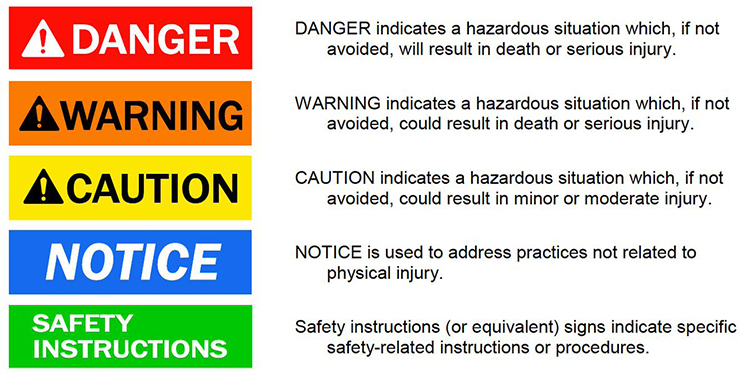Understanding Safety Signs And Overhead Lifting Equipment Hazards

As heavy industrial equipment designed and engineered to lift, transport, and maneuver large, dense loads throughout a facility, overhead handling systems — including cranes, hoists, and monorails — can pose safety hazards to operators and other personnel if they are not used correctly or with proper care. To help reduce the risk of injury, safety signs are added to the equipment to advise users about the nature and degree of the associated hazards. They can take the form of a decal, label, placard, cord tag, embossing, stamping, or etching and may describe safety precautions or evasive actions to take. The signs may also provide instructions to eliminate or reduce the hazard.
Product safety signs incorporate one of four key signal words that designate a degree or level of hazard seriousness: “DANGER,” “WARNING,” “CAUTION,” and “NOTICE.” Their use and application are defined by two separate standards:
- The American Society of Mechanical Engineers’ standard 2-2016: Overhead and Gantry Cranes, section 2-1.1.5 states the following about warnings:
-
- Floor-operated and remote operated cranes. A safety label or labels SHALL be affixed to the pendant station, portable operating station, or load block. The label or labels shall be in compliance of ANSI Z535.4. Labels shall include but are not limited to cautionary language against exceeding rated load, hoisting off-centered loads, lifting people, lifting loads over people and operating damaged or malfunctioning crane.
- Cab-operated and pulpit operated cranes. A safety label or labels SHALL be affixed to the cab or pulpit. The label or labels shall be in compliance of ANSI Z535.4. Labels shall include but are not limited to cautionary language against exceeding rated load, hoisting off-centered loads, lifting people, lifting loads over people and operating damaged or malfunctioning crane.
- Electrical control enclosures. A safety label shall be affixed and shall be in compliance with ANSI Z535.4.
- The American National Standards Institute’s ANSI Z535.4-2011 (R2017): Product Safety Signs and Labels defines the four key signal words as follows:
- DANGER – Indicates a hazardous situation which, if not avoided, will result in death or serious injury. This signal word is to be limited to the most extreme situations. The word DANGER shall be in safety white letters on a safety red background.
- WARNING – Indicates a hazardous situation which, if not avoided, could result in death or serious injury. The word WARNING shall be in safety black letters on a safety orange background.
- CAUTION – Indicates a hazardous situation which, if not avoided, could result in minor or moderate injury. It may also be used without the safety alert symbol as an alternative to “NOTICE”. The word CAUTION shall be in safety black letters on a safety yellow background.
- NOTICE – “NOTICE” is the preferred signal word to address practices not related to personal injury. The safety alert symbol shall not be used with this signal word. As an alternative to “NOTICE”, the work “CAUTION” without the safety alert symbol may be used to indicate a message not related to personal injury. The word NOTICE shall be in white letters on a safety blue background.
Best practices for the application and usage of safety signs include ensuring they are placed on the product in a manner and orientation that enables a user to see and read them from a safe distance. They should also be affixed in a way that does not distract employees or cause a hazardous situation. They should not be applied to areas where the motion of the hazardous device may remove them. All wording should be concise and easy to understand. If multiple messages must be included in one sign, sufficient space should be used between them for visual clarity; if detailed instructions are required, the sign should refer the reader to the manufacturer’s operation manual.
As part of a pre-shift inspection, an operator should confirm the presence and legibility of any product safety signs attached to the crane, hoist, or monorail system as one of several pre-operational checklist items. If an issue is discovered, the unit (or units) should be removed from service immediately.
Want to learn more about overhead lifting safety? The three members of the Overhead Alliance — the Crane Manufacturers Association of America (CMAA), Hoist Manufacturers Institute (HMI) and the Monorail Manufacturers Association (MMA) — each offer in-depth resources, standards, specifications, and safety checklists specific to that type of equipment. Additionally, the three recently gained ambassador status with OSHA’s Crane, Hoist and Monorail Alliance (CHM), and will promote cooperative programs with the federal agency, raising awareness of OSHA’s initiatives, outreach, communication, training and education, and also providing information, guidance and access to training resources that help protect the health and safety of workers using hoists, cranes and monorails.



